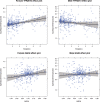The low prevalence of female smoking in the developing world: gender inequality or maternal adaptations for fetal protection?
- PMID: 27193200
- PMCID: PMC4931906
- DOI: 10.1093/emph/eow013
The low prevalence of female smoking in the developing world: gender inequality or maternal adaptations for fetal protection?
Abstract
Background: Female smoking prevalence is dramatically lower in developing countries (3.1%) than developed countries (17.2%), whereas male smoking is similar (32% vs 30.1%). Low female smoking has been linked to high gender inequality. Alternatively, to protect their offspring from teratogenic substances, pregnant and lactating women appear to have evolved aversions to toxic plant substances like nicotine, which are reinforced by cultural proscriptions. Higher total fertility rates (TFRs) in developing countries could therefore explain their lower prevalence of female smoking.
Objective: To compare the associations of TFR and gender inequality with national prevalence rates of female and male smoking.
Methods: Data from a previous study of smoking prevalence vs gender inequality in 74 countries were reanalysed with a regression model that also included TFR. We replicated this analysis with three additional measures of gender equality and 2012 smoking data from 173 countries.
Results: A 1 SD increase in TFR predicted a decrease in female smoking prevalence by factors of 0.58-0.77, adjusting for covariates. TFR had a smaller and unexpected negative association with male smoking prevalence. Increased gender equality was associated with increased female smoking prevalence, and, unexpectedly, with decreased male smoking prevalence. TFR was also associated with an increase in smoking prevalence among postmenopausal women.
Conclusions: High TFR and gender inequality both predict reduced prevalence of female smoking across nations. In countries with high TFR, adaptations and cultural norms that protect fetuses from plant toxins might suppress smoking among frequently pregnant and lactating women.
Keywords: drug toxicity; global health; pregnancy aversions; substance use; tobacco control.
© The Author(s) 2016. Published by Oxford University Press on behalf of the Foundation for Evolution, Medicine, and Public Health.
Figures





References
-
- Ng M, Freeman MK, Fleming TD. et al. Smoking prevalence and cigarette consumption in 187 countries, 1980-2012. JAMA 2014; 311:183–92. - PubMed
-
- United Nations, Department of Economic and Social Affairs, Population Division. World Population Prospects: The 2015 Revision, Volume I: Comprehensive Tables ST/ESA/SER.A/379 2015. New York: United Nations.
-
- United Nations Development Programme. Human Development Report 1995: Gender and Human Development. Oxford: Oxford University Press, 1995.
-
- Brown JK. Cross-cultural perspectives on middle-aged women. Curr Anthropol 1982; 23:143–56.
LinkOut - more resources
Full Text Sources
Other Literature Sources
Molecular Biology Databases

